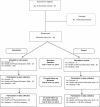A cluster randomised trial of a school-based intervention to prevent decline in adolescent physical activity levels: study protocol for the 'Physical Activity 4 Everyone' trial
- PMID: 23336603
- PMCID: PMC3577490
- DOI: 10.1186/1471-2458-13-57
A cluster randomised trial of a school-based intervention to prevent decline in adolescent physical activity levels: study protocol for the 'Physical Activity 4 Everyone' trial
Abstract
Background: Adolescence is an established period of physical activity decline. Multi-component school-based interventions have the potential to slow the decline in adolescents' physical activity; however, few interventions have been conducted in schools located in low-income or disadvantaged communities. This study aims to assess the effectiveness of a multi-component school-based intervention in reducing the decline in physical activity among students attending secondary schools located in disadvantaged communities.
Methods/design: The cluster randomised trial will be conducted with 10 secondary schools located in selected regions of New South Wales, Australia. The schools will be selected from areas that have a level of socio-economic status that is below the state average. Five schools will be allocated to receive an intervention based on the Health Promoting Schools framework, and will be supported by a part-time physical activity consultant placed in intervention schools who will implement a range of intervention adoption strategies. Study measures will be taken at baseline when students are in Year 7 (12-13 years) and again after 12- and 24-months. The primary outcome, minutes of moderate- to-vigorous- intensity physical activity per day and percentage of time in moderate- to vigorous-intensity physical activity (MVPA), will be objectively assessed using accelerometers (Actigraph GT3x+). Group allocation and intervention delivery will commence after baseline data collection. The intervention will continue during school terms through to 24-month follow-up.
Discussion: The study will provide evidence regarding the effectiveness of a multi-component school-based intervention that includes an in-school physical activity consultant targeting the physical activity levels of adolescents in disadvantaged Australian secondary schools.
Trial registration: Australian New Zealand Clinical Trials Registry ACTRN12612000382875.
Figures
References
-
- Min Lee ISE, Lobelo F, Puska P, Blair SN, Katzmarzyk PT. for the Lancet Physical Activity Series Working Group. Effect of physical inactivity on major non-communicable diseases worldwide: an analysis of burden of disease and life expectancy. Lancet. 2012;380(9838):219–229. doi: 10.1016/S0140-6736(12)61031-9. - DOI - PMC - PubMed
-
- Centers for Disease Control and Prevention (CDC) MMWR. Volume 59. CDC, United States of America; 2010. Youth Risk Behavior Surveillance-United States, 2009; pp. 1–142. - PubMed
-
- NHS Statistics on obesity physical activity and diet: England 2012. [ http://www.ic.nhs.uk/pubs/opad12]
-
- Morley B, Scully M, Niven P, Baur LA, Crawford D, Flood V, Okely AD, Pratt IS, Salmon J, Wakefield M, for the NaSSDA Study Team. Prevalence and socio-demographic distribution of eating, physical activity and sedentary behaviours among Australian adolescents. Health Promot J Austr. 2012. In press. - PubMed
Publication types
MeSH terms
LinkOut - more resources
Full Text Sources
Other Literature Sources
Medical



